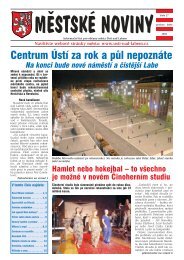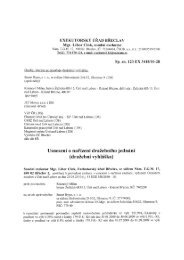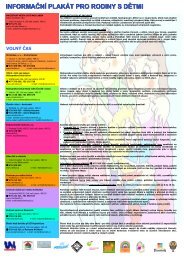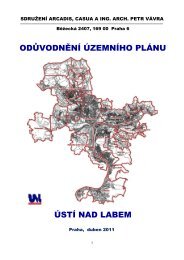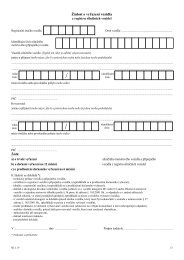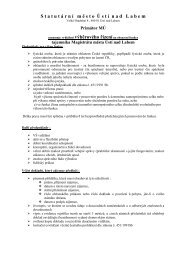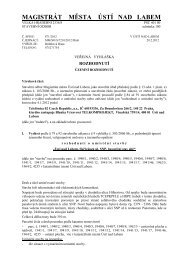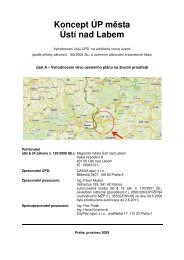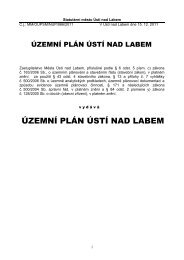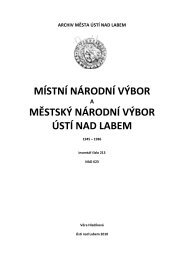Historie a památky města Ústí nad Labem History and monuments of ...
Historie a památky města Ústí nad Labem History and monuments of ...
Historie a památky města Ústí nad Labem History and monuments of ...
Sie wollen auch ein ePaper? Erhöhen Sie die Reichweite Ihrer Titel.
YUMPU macht aus Druck-PDFs automatisch weboptimierte ePaper, die Google liebt.
44<br />
CZ ENG DE<br />
ho freikorpsu v okolí a mobilizací československého vojska. To<br />
se však muselo záhy stáhnout za nové hranice a spolu s vojáky<br />
odcházeli i čeští obyvatelé. Mnozí z nich se však po odmítnutí<br />
ve vnitrozemí znovu vraceli. Dne 9. října vstoupily do <strong>města</strong><br />
za mohutného vítání první jednotky wehrmachtu. Dovršením<br />
„osvobození“ byly doplňovací volby do říšského sněmu, které<br />
byly zároveň formou plebiscitu. 99,54% odevzdaných hlasů<br />
souhlasilo s připojením k říši.<br />
Dne 1. května 1939 došlo připojením <strong>města</strong> Střekova a obcí<br />
Bukov, Hostovice, Předlice, Stříbrníky a Trmice k vytvoření<br />
„Velkého <strong>Ústí</strong>“. V průběhu okupace zde žilo přibližně 2000<br />
Čechů s tzv. občanstvím Protektorátu Čechy a Morava, z toho<br />
asi 200 ve vnitřním městě. Jejich postavení bylo nerovnoprávné<br />
a byli nuceni dodržovat mnohá restriktivní nařízení. Tvrdá opatření<br />
byla uplatňována vůči židům, z nichž poslední byli v letech<br />
1941-1942 internováni v Krásném Lese a deportováni do vyhlazovacích<br />
táborů. Části se však podařilo opustit město ještě před<br />
nacistickou okupací jako např. rodině Petschků » a Weinmannů<br />
», které emigrovaly do Velké Británie a později do USA. Přes<br />
krajně nepříznivé podmínky působila v prvních letech války v<br />
okolí <strong>města</strong> komunistická odbojová skupina Herty Lindnerové.<br />
Culture, particularly theatre <strong>and</strong> music, played a<br />
very important part in <strong>Ústí</strong> <strong>nad</strong> <strong>Labem</strong>, also because<br />
<strong>of</strong> the many renowned artists from Germany,<br />
which they left at the beginning <strong>of</strong> the 1920´s due<br />
to the bad economic situation <strong>and</strong> later, particularly<br />
due to racial persecution. Culture was also<br />
encouraged by renowned representatives <strong>of</strong> the<br />
city as well as entrepreneurs <strong>and</strong> industrialists.<br />
The Munich Agreement <strong>of</strong> 30 September 1938<br />
brought an end to this era. The atmosphere in <strong>Ústí</strong><br />
<strong>nad</strong> <strong>Labem</strong> was very tense before Munich. It was<br />
accompanied by huge demonstrations attended by<br />
thous<strong>and</strong>s <strong>of</strong> people who dem<strong>and</strong>ed „affiliation to<br />
the Reich“. There were also frequent cross-border<br />
assaults by the Sudetendeutsche Freikorps in the<br />
neighbourhood <strong>and</strong> finally, the situation culminated<br />
with the mobilisation <strong>of</strong> the Czechoslovak army.<br />
However, soon a<br />
new borderline was<br />
demarcated <strong>and</strong> the<br />
Czech army had to<br />
withdraw from the<br />
area followed by the<br />
Czech population.<br />
35 However, being<br />
rejected inl<strong>and</strong>, they<br />
came back again. On 9 October,<br />
the first Wehrmacht troops<br />
entered the town with an overwhelming<br />
welcome. The “liberation”<br />
was completed by the byelection<br />
for the Reichstag, in the<br />
form <strong>of</strong> a plebiscite. 99.54% <strong>of</strong><br />
the cast votes agreed with the<br />
affiliation to the Reich.<br />
On 1 May 1939, “Big <strong>Ústí</strong>” was<br />
formed by merging the town <strong>of</strong><br />
Střekov <strong>and</strong> the municipalities <strong>of</strong><br />
Bukov, Hostovice, Předlice,<br />
Stříbrníky <strong>and</strong> Trmice. Throughout<br />
the years <strong>of</strong> the occupation,<br />
approximately 2000 Czech people<br />
lived in the town with so-called<br />
citizenship <strong>of</strong> the Protectorate<br />
<strong>of</strong> Bohemia <strong>and</strong> Moravia,<br />
about 200 <strong>of</strong> which in the centre.<br />
Their status was unequal as<br />
größte Entwicklung erlebte. In der Werbeabteilung der Filmatelies<br />
wurde das erste Mal in der Tschechoslowakei der Tonfilm<br />
präsentiert, welcher am 29. April 1929 im damaligen „Revue<br />
Alhambra“, dem heutigen Činoherní studio (Hörspielstudio),<br />
gezeigt wurde.<br />
Die Kultur <strong>Ústí</strong> <strong>nad</strong> <strong>Labem</strong> spielte eine wichtige Rolle, vor allem<br />
Theater und Musik. Dies war auch dank einer Reihe von guten<br />
Künstlern aus Deutschl<strong>and</strong> – von dort kamen sie am Anfang der<br />
20er Jahre wegen schlechter wirtschaftlicher Situation und<br />
später dann vor allem wegen rassistischer Verfolgung. Unterstürzt<br />
wurde Kultur ebenfalls von bedeutenden Stadtrepräsentanten,<br />
Unternehmern und Wirtschaftlern.<br />
Das Münchener Abkommen vom 30. September 1938 bedeutete<br />
das Ende dieser Periode. In <strong>Ústí</strong> <strong>nad</strong> <strong>Labem</strong> ging ihr eine<br />
sehr gespannte Situation voran, begleitet von Demonstrationen<br />
mit tausenden Leuten, deren Teilnehmer „Rückkehr ins Reich“<br />
36



